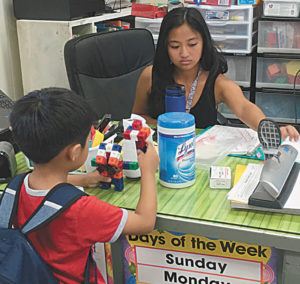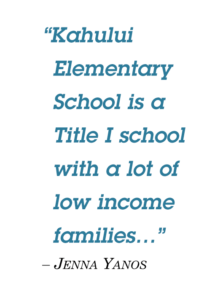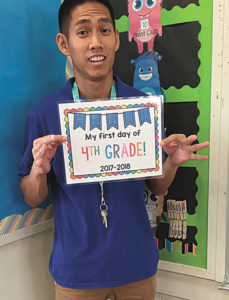
Photo: Stacy Woodson.
Back to School in 2017.
As teachers and administrators of Maui’s schools prepared for the imminent opening of the 2017–2018 school year, hundreds of parents faced transportation challenges for their youngsters. The State had awarded a new school bus contract to Ground Transport, Inc. to service Baldwin High School, Lahainaluna High School, and Maui High School but Ground Transport did not have enough qualified drivers. This last minute back to school wrinkle forced parents to scramble. “My kids have depended on the school bus services for many years but with the new school year and no buses for my kids for ‘Īao School and Baldwin, it was very disconcerting,” said Lyn Alpuro. “We are having to get up a little earlier and leaving the house earlier to avoid the traffic.”

Photo: Bradley Cacayorin
The rise in commuters has led to more traffic that’s affected students and teachers. “There’s a lot of traffic now because parents need to drop off and pick up their kids,” said Haile Evangelista, a senior at Maui High School. At nearby Kahului Elementary School, parents are parking in teachers’ stalls. “There’s a lot of commuter traffic and the parents are parking in staff spaces,” said Bradley Cacayorin, a fourth grade teacher at Kahului Elementary School. “So teachers can’t park at school.”
The failure of Ground Transport to provide enough bus drivers and the failure of the Department of Education to quickly come up with a resolution is just one of the shortcomings of the Department of Education. For over ten years, the lack of air conditioning at public schools has been a news item. A few years ago, the teachers’ union, HSTA, even suggested canceling school on Heat Days. While the Department of Education has begun installing air conditioning units at some schools, for some teachers, the timing represents a lack of planning. “I feel challenged because of the timing when they started to renovate our classrooms,” said Cacayorin. “They’re adding AC units but it won’t work for another two months. It delayed my time to set up and my time to plan for the school year.” As Jenna Yanos, a kindergarten teacher at Kahului Elementary School said, “The air conditioning won’t be there at the hottest time.”
 The Department of Education is going through some transition, with the non-renewal of the contract of School Superintendent Kathryn Matayoshi, the selection of Christina Kawamoto from Arizona as the new School Superintendent (she started the week before school started), and Governor David Ige’s release in July of the final draft of Hawai‘i’s Blueprint for Education. Just a few years ago, HSTA elected a new slate of officials. The new HSTA officials successfully negotiated a new four year contract for teachers that will result in a 13.5% increase over four years. “The union is more visible than before,” said Cacayorin “but I never really see much change.” Although teachers received raises, they still incur a lot of unpaid time. “We’re paid from 7:45 a.m. till 2:45 p.m.” said Yanos. “But we stay at school, usually until 4 p.m. At home, I spend an average of two hours each day, doing work.” Yanos, who begins her second year in teaching, receives the same annual salary ($48,000) as Cacayorin, who begins his fifth year of teaching.
The Department of Education is going through some transition, with the non-renewal of the contract of School Superintendent Kathryn Matayoshi, the selection of Christina Kawamoto from Arizona as the new School Superintendent (she started the week before school started), and Governor David Ige’s release in July of the final draft of Hawai‘i’s Blueprint for Education. Just a few years ago, HSTA elected a new slate of officials. The new HSTA officials successfully negotiated a new four year contract for teachers that will result in a 13.5% increase over four years. “The union is more visible than before,” said Cacayorin “but I never really see much change.” Although teachers received raises, they still incur a lot of unpaid time. “We’re paid from 7:45 a.m. till 2:45 p.m.” said Yanos. “But we stay at school, usually until 4 p.m. At home, I spend an average of two hours each day, doing work.” Yanos, who begins her second year in teaching, receives the same annual salary ($48,000) as Cacayorin, who begins his fifth year of teaching.

Photo courtesy Bradley Cacayorin
A continuing challenge for teachers is the lack of school supplies. “There’s still not enough supplies for the curriculum. We are short of workbooks,” said Cacayorin. “My biggest challenge will be some kids are not prepared for kindergarten,” said Yanos. “For example, some families can’t afford school supplies so I have to buy a lot of stuff. To date, I’ve spent over $200 of my own money to buy stuff like crayons, tablets, folders, Kleenex®, hand soap, sanitizer, and materials for projects.” Cacayorin said he had to buy supplies for his whole class and spent $500 of his own funds to buy tablets, folders, pens, pencils, and binders. “Kahului Elementary School is a Title I school with a lot of low income families,” explained Yanos, “and there’s a lot of students with English as their second language.” The majority of Cacayorin’s students are of Filipino ancestry.
The lack of school supplies also hit vendors. Some vendors ran out of items and asked customers to return in a few weeks to check on their missing supplies. One parent posted on Facebook and asked if anyone found oil pastels or unruled composition books. The parent did not want recommendations on where to try but vendors who had a supply. Another parent chimed in that she was also looking for those same items. Facebook friends suggested Walmart, Ben Franklin, Longs, Ace, Foodland, Office Max, and Barnes & Noble. A Facebook friend suggested Amazon while a family who was on O‘ahu volunteered to check stores on O‘ahu. Another Facebook friend said she gets all of her kids’ oil pastels from the Philippines.

Photo courtesy Rose Anne Rafael
The mix of emotions ranges from high anticipation to profound fear, with hints of sadness. “I’m kind of sad this is my final year of high school. I don’t want to leave,” said Evangelista. Joseph Lampitoc, a senior at Baldwin High School explained: “With this being my final first school day until college, seeing everyone and all of my friends was familiar yet new. Even still, although I have been going to the school for four years at this point attending still set a new nervousness through my body. Anyways the first day of school was like all the others while still being new and exciting.”
At the high schools, student leaders helped with registration tips, prepared packets with handbooks, events and activities information, and a list of counselors, phone numbers and room numbers where help is available. Before the first day of school, students needed to register for classes. You could tell who did not get the schedule they wanted by the looks on their faces and the sputters of inaudible expletives, or an occasional scream of joy from an overly exuberant student who just found out he passed his summer school class, and did not have to repeat the grade.
Younger children and their parents perhaps are the most anxious. Rheena Lynne Acidera Campbell, mother of a 2nd grader and a preschooler noted the difference between her two sons. “As a parent, I always prepare my children emotionally by going over the events of the day. My 2nd grader told me as we pulled up to school, ‘Mom, today you may walk me to class to help with my school supplies but tomorrow just drop me off at the gate. You don’t have to walk me to class.’ I’m proud of the confidence and independence my son has but at the same time I want to cry because he doesn’t need his mom to hold his hand,” said Campbell. Her pre-school age son, however, had a different take. “Today, my younger son, who will be attending his first day of pre-school next week said ‘Mom maybe we can cancel preschool!’ After asking him if he was scared he replied, ‘I’m scared of the kids. I don’t know anyone.’ I reassured my youngest son that he will make friends immediately and there were so many great activities at preschool. As a parent, the hardest part is walking away from your child’s classroom as they get ready for their school day. It is difficult because of the emotions that are attached to being a parent and needing to let go so your children can grow and experience life.”
Pre-school activities open all the portals of learning for the toddlers who engage in the prepared environment, designed to optimize the natural modes of learning which are switched on at birth. Curiosity is the unstoppable driver for the youngster, who makes a beeline towards everything that arouses interest. Many of these moments are fleeting, and we have not yet figured out how to measure or define what is learned in each brief encounter. One thing for sure, we now agree that humans are social beings, and that healthy interactions between people at every age promote, reinforce and encourage self-confidence, many interests in what life has to offer, and higher likelihood of emerging leadership, and ultimately, the willingness to open our hearts to love. Resiliency of spirit is built upon hard lessons of disappointment, self-doubt, heartbreak, and loss. The reliance on self, on the belief that we have a reserve of strength when we need it, the confirmation from those who love us that we are valuable to the world, and that we matter to someone, all serve to connect us heart to heart. Being loved makes us forgiving because from facing hard truths, we truly understand that even in our imperfection, we can do something good with our life. These early lessons are all part of the fabric of learning. Some lessons are needed again and again. Yes, it is also true, that some lessons will take us a whole lifetime to learn.
With middle school being the world of uncertainty and conflict, it is refreshing to hear eighth grader Keilah Galiza being excited. “I can’t keep calm, it’s back to school. Where did the summer go? It’s not going to be easy but I will try my best and enjoy every moment of my school year.” Keilah’s sister, Vanessa, who will enter her second year of college at the University of Hawai‘i Maui College had a more sophisticated outlook: “Paint this new school year with a whole box of crayons.”
Zyra Dela Cruz, who will be a sophomore at the University of Nevada, Las Vegas, majoring in Hospitality Management spent the summer on Maui working at the State of Hawai‘i Department of Transportation, had mixed feelings about going back to school: “Going back to school is bittersweet for me because I love Maui so much and I don’t want to leave my family. But at the same time, I’m looking forward to starting a new year in my own apartment with my best friend. Also, I’m really excited for another journey of experiences and adventures away from home.” Zyra’s cousin Sheena Dela Cruz, who will be in her third year in college, did not come home for the summer to save money by working at Home Depot as a specialist. She spent her first two years at California State University, East Bay and will transfer to Foothill College in Los Altos, California, majoring in Dental Hygiene. “I was majoring in Biochemistry but I decided to change majors because after two years, I realized that was not my field. I wasn’t happy at East Bay so I decided to change schools. I’m looking forward to a new environment but I miss home so bad. I’m praying that I’ll be able to come home for a week in December and eat good, delicious food, especially at the Food Trucks.”

Photo courtesy Nathaniel Idica
 Nathaniel Idica, who will be a sophomore at Whitworth University in Spokane, Washington changed his major three times last year because he wasn’t really sure about what he wanted to do. He started as a Biochemistry major, switched to Chemistry, and now is majoring in Math. “I’m planning to become a Chemical Engineer so I plan to enter the dual degree program.” Idica worked at the State of Hawai‘i Department of Transportation as well as Tutti Frutti in Kahului. As far as looking forward to going back to school, Idica said yes and no. “Yes because I have so many friends there but no because politically-wise, it’s very tense at my school. Plus, this summer I came out of the closet. It was a big step for me and I was not sure how people would react but my family and friends have all supported me and showed me their love and understanding.”
Nathaniel Idica, who will be a sophomore at Whitworth University in Spokane, Washington changed his major three times last year because he wasn’t really sure about what he wanted to do. He started as a Biochemistry major, switched to Chemistry, and now is majoring in Math. “I’m planning to become a Chemical Engineer so I plan to enter the dual degree program.” Idica worked at the State of Hawai‘i Department of Transportation as well as Tutti Frutti in Kahului. As far as looking forward to going back to school, Idica said yes and no. “Yes because I have so many friends there but no because politically-wise, it’s very tense at my school. Plus, this summer I came out of the closet. It was a big step for me and I was not sure how people would react but my family and friends have all supported me and showed me their love and understanding.”
At colleges and universities, students like Sheena Dela Cruz and Idica are reassessing to discover whether their original college plans are still on track. The availability of classes always plays a role and the sabbatical schedule of professors limit when classes will be taught. Housing and roommate issues also come into play—something most students never faced during high school. For soon to be college graduates, the relevancy of their field of study is a major concern with many wondering whether there will be a job waiting for them.
Yet, students and their parents are excited for the new year. “My children and I had a great summer and I look forward to what they’ll be learning in school this year but I’m dreading the traffic that will come when UH Maui begins their traffic,” said Natasha Lau, parent of a pre-schooler and a seventh grader at Kamehameha Schools-Maui. “Aside from the bus situation, back to school has been somewhat smooth, an easy transition from summer vacation,” said Alpuro.
Despite the transportation and school supply challenges, most teachers had a positive outlook. “I think this year will be better than last year,” said Yanos. “Last year was my first year and I was inexperienced and trying to learn everything. But all the other teachers at school really helped. All the teachers support each other.”
The new school year is above all an opportunity to accomplish more than before, to get clear about the next steps in the path to a successful future, to take corrective action for previous mistaken judgement, and to build a strong, well-designed bridge that can take you to the place of your dreams. Be bold. Take the risk. Make the leap of faith. You will never find out what you are made of until you choose to take a chance on yourself, to show the world that no matter what, you believe it is your responsibility, that you are in charge of bringing into the light the best that you can be.
Elizabeth Ayson, Ph.D., is a retired educator, having served in the State Department of Education for over forty years. She previously served as the Principal at ‘Īao Intermediate School, the Vice Principal at Lihikai Elementary School and Maui High School, and she taught at Lihikai Elementary School, Blanche Pope School in Waimānalo, O‘ahu, Frank Thompson Middle School in Boston, Massachusetts, and Stuart Elementary School in Boston, Massachusetts. She was graduated from Baldwin High School, Knox College in Galesburg, Illinois (majoring in Music Education and Elementary Education), and University of Hawai‘i at Mānoa (M.Ed.). She received her doctorate from Union University in Cincinnati, Ohio.
Alfredo G. Evangelista contributed to this article.
